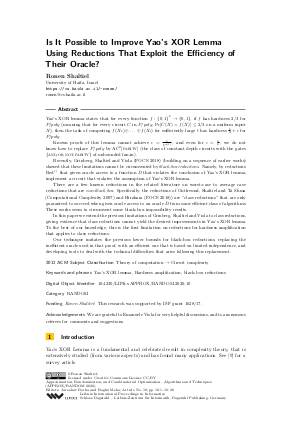@InProceedings{shaltiel:LIPIcs.APPROX/RANDOM.2020.10,
author = {Shaltiel, Ronen},
title = {{Is It Possible to Improve Yao’s XOR Lemma Using Reductions That Exploit the Efficiency of Their Oracle?}},
booktitle = {Approximation, Randomization, and Combinatorial Optimization. Algorithms and Techniques (APPROX/RANDOM 2020)},
pages = {10:1--10:20},
series = {Leibniz International Proceedings in Informatics (LIPIcs)},
ISBN = {978-3-95977-164-1},
ISSN = {1868-8969},
year = {2020},
volume = {176},
editor = {Byrka, Jaros{\l}aw and Meka, Raghu},
publisher = {Schloss Dagstuhl -- Leibniz-Zentrum f{\"u}r Informatik},
address = {Dagstuhl, Germany},
URL = {https://drops.dagstuhl.de/entities/document/10.4230/LIPIcs.APPROX/RANDOM.2020.10},
URN = {urn:nbn:de:0030-drops-126138},
doi = {10.4230/LIPIcs.APPROX/RANDOM.2020.10},
annote = {Keywords: Yao’s XOR lemma, Hardness amplification, black-box reductions}
}

 Creative Commons Attribution 3.0 Unported license
Creative Commons Attribution 3.0 Unported license



